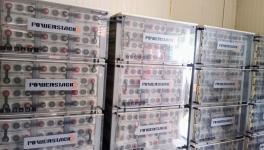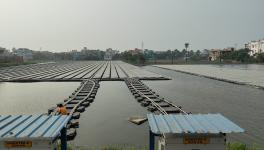TN: Thermal Power Plant Emissions Continue Pollution, 4 Cities are SO₂ Hotspots
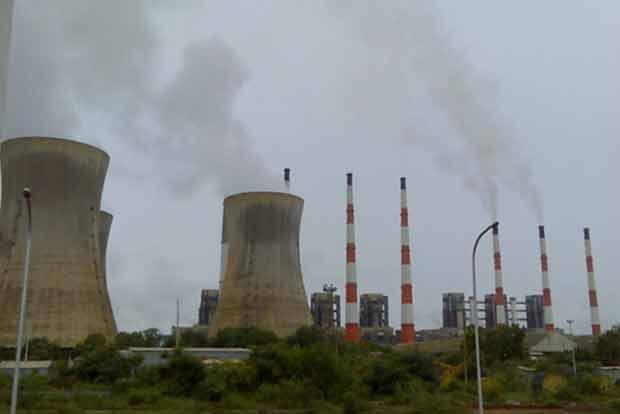
Representational Image. Image Courtesy: DTNext
The thermal power plants (TPS) in Tamil Nadu continue to pollute four major cities, raising severe health concerns. The emissions from these plants are way beyond the prescribed level, a recent study has found.
The absence of Flue Gas Desulfuriser (FGD), which controls SO2 and NOx pollution, in 38 of the 40 operational units remains a cause of concern. Besides, discrepancies between power plant emission data obtained through RTI and data provided by the Tamil Nadu Pollution Control Board (TNPCB) expose the government’s lack of concern on emissions.
With 7.5GW coal-based thermal power plants under various stages of completion, a few more cities across the state could face increased pollution of particulate matter (PM₂.₅,), given the failure of the TNPCB in acting against violation of emission norms.
Chennai, Neyveli, Thoothukudi and Mettur are the cities hosting the TPS, and are among the 50 cities found to be SO₂ hotspots globally in 2020.
HIGH PM2.5 EMISSION
Of the 50 highly polluted cities across the globe, 35 are from India as of 2020. Though the cities in Tamil Nadu do not feature on this list, the emission from the thermal power stations has violated norms on most of the days in a year.
Against the daily average prescribed level of 25 μg/m3 of PM₂.₅--a fine particulate matter that acts as an air pollutant--Chennai recorded a higher value on 188 days in 2020.
A research carried out by Poovulagin Narnbargal and the Centre for Research on Energy and Clean Air points to the absence of air quality monitoring in several other cities as the reason for the unavailability of data.
“Lack of publicly available data helps cover up the wrongdoings committed by industries and other polluting sectors in such areas,” the research report said. Air pollution has reduced in Chennai in the last three years, “but the thermal stations continue to operate without adequate technology and equipment resulting in health hazards,” the report said.
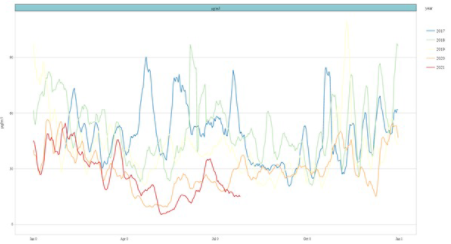
Image: Air Pollution (PM₂.₅) levels in Chennai since January 2017 till June 2021 (Courtesy: Emission watch: Status assessment of SO₂ emission and FGD installation for coal-based power plants in Tamil Nadu).
Tamil Nadu has 28 manual National Air Quality Monitoring Program (NAMP) stations installed across eight cities while there are 36 Continuous Ambient Air Quality Monitoring Stations (CAAQMS) installed across the state, with Chennai having the most of them. In Chennai, eight monitoring stations are manual and another eight are CAAQMS.
SO₂ EMISSION HOTSPOTS
The four cities hosting the thermal stations have become SO₂ hotspots in the 2020 report.
“The absence of FGD in the thermal stations is the primary reason for the higher emissions,” Prabhakaran, an environmental engineer at Poovulagin Nanbargal, told Newsclick. “Only two of the 40 functional thermal units (have FGD) and eight have placed bids for the same. With the deadline for installing FGD ending in 2024, the state would not be able to fulfil it,” he said.
SO₂ and NOx are reactive gases, leading to the formation of PM₂.₅, which causes numerous poor health outcome indicators in India.

Image: SO₂ emission hotspots in Tamil Nadu featured in the global SO₂ hotspot list (CREA & Greenpeace, 2020) (Courtesy: Emission watch: Status assessment of SO2 emission and FGD installation for coal-based power plants in Tamil Nadu)
“The Neyveli thermal station emits six times the permissible SO2 levels while Vallur and Thoothukudi plants emit four times the permissible levels. The discrepancies in the RTI response and data in the TNPCB website are indicators of the very less importance given to the pollution norms in the state,” Prabhakaran said.
MORE THERMAL PLANTS UNDER CONSTRUCTION
More thermal power stations are under construction in Tamil Nadu, which will increase the concern of higher pollution in the near future. Tamil Nadu currently has an installed capacity (including allocation from central generating stations) of 33,696 MW against a calculated peak demand of 19,240 MW during 2020–21.
“The demand for electricity has been lower than the prediction. But the state government is proceeding with more units in existing and new locations. The efficiency of existing plants is around 53%. We can increase the efficiency and avoid the new plants,” said Prabhakaran.
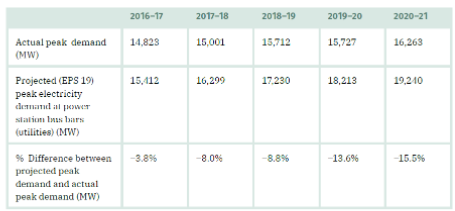
Image: Projected vs. actual peak demand for Tamil Nadu (MW) (Courtesy: Emission watch: Status assessment of SO2 emission and FGD installation for coal-based power plants in Tamil Nadu)
Being debt-ridden, Tamil Nadu Generation and Distribution Corporation (TANGEDCO) would not be able to afford to install FGDs in the upcoming thermal stations. “The government should decommission the old plants and improve the efficiency of the existing plants, which will help improve the financial status as well,” Prabhakaran said.
The thrust for tapping energy from renewable energy sources has been rising over the past few years. With high and dangerous emissions from coal power thermal stations proving disastrous, the sector needs greater attention. “More diverse renewable energy plants should be planned to meet the demands and reduce pollution,” Prabhakaran added.
Get the latest reports & analysis with people's perspective on Protests, movements & deep analytical videos, discussions of the current affairs in your Telegram app. Subscribe to NewsClick's Telegram channel & get Real-Time updates on stories, as they get published on our website.










